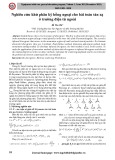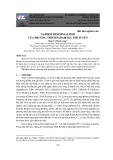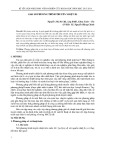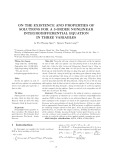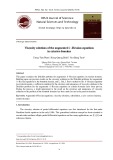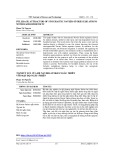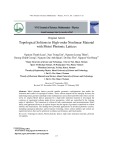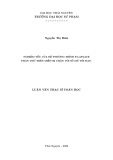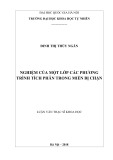
TNU Journal of Science and Technology
230(02): 152 - 159
http://jst.tnu.edu.vn 152 Email: jst@tnu.edu.vn
PULLBACK ATTRACTOR OF STOCHASTIC NAVIER-STOKES EQUATIONS
WITH RANDOM DENSITY
Pham Tri Nguyen *
Electric Power University
ARTICLE INFO
ABSTRACT
Received:
10/01/2025
This paper studies the two dimensional Navier Stokes equations driven
by random density, additive white noise and time dependent forces on
bounded domain. The result shows that when the noise is zero and the
random density is identical to one, the system becomes the classical
incompressible Navier Stokes equation system. In addition, for the
bounded domain, the Poincaré inequality is satisfied. By applying the
Ornstein Uhlenbeck process, the stochastic system is transformed into a
deterministic one with random parameters. Then, using the Faedo
Galerkin approximations method we obtain the existence and unique
weak solution for the system as well as the continuity of the solution
with respect to its initial data. Next, a continuous cocycle for the
equations is defined, the existence and unique pullback attractor of the
system is proven. Noteworthy, for bounded domains, the use of the
Sobolev embedding theorem helps to obtain the asymptotic
compactness of the solution.
Revised:
17/02/2025
Published:
19/02/2025
KEYWORDS
Stochastic Navier-Stokes
equations
Pullback attractor
Random density
Bounded domain
Additive noise
TẬP HÚT LÙI CỦA HỆ NAVIER-STOKES NGẪU NHIÊN
VỚI MẬT ĐỘ NGẪU NHIÊN
Phạm Trí Nguyễn
Trường Đại học Điện lực
THÔNG TIN BÀI BÁO
TÓM TẮT
Ngày nhận bài:
10/01/2025
Bài báo này nghiên cứu hệ phương trình Navier Stokes hai chiều được
điều khiển bởi mật độ ngẫu nhiên, nhiễu ngẫu nhiên cộng tính và ngoại
lực phụ thuộc thời gian trong miền bị chặn. Kết quả cho thấy rằng khi
nhiễu bằng không và mật độ ngẫu nhiên đồng nhất bằng một thì hệ trở
thành hệ phương trình Navier Stokes không nén được cổ điển. Ngoài ra,
đối với miền bị chặn, bất đẳng thức Poincaré được thỏa mãn. Bằng cách
áp dụng quá trình Ornstein Uhlenbeck, hệ ngẫu nhiên được chuyển thành
hệ tất định với các tham số ngẫu nhiên. Từ đó, sử dụng phương pháp xấp
xỉ Faedo Galerkin chúng tôi thu được sự tồn tại và duy nhất nghiệm yếu
của hệ cũng như tính liên tục của nghiệm đối với dữ liệu ban đầu của nó.
Tiếp theo, một đối chu trình liên tục cho hệ phương trình được định
nghĩa, sự tồn tại và duy nhất tập hút lùi của hệ được chứng minh. Đáng
chú ý, đối với miền bị chặn, việc sử dụng định lý nhúng Sobolev giúp thu
được tính compact tiệm cận của nghiệm.
Ngày hoàn thiện:
17/02/2025
Ngày đăng:
19/02/2025
TỪ KHÓA
Hệ Navier-Stokes ngẫu nhiên
Tập hút lùi
Mật độ ngẫu nhiên
Miền bị chặn
Nhiễu cộng tính
DOI: https://doi.org/10.34238/tnu-jst.11859
Email: nguyench13@gmail.com





